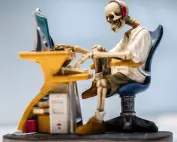How to build your personal productivity
Personal productivity is the hot word of the day with business articles chock full of tips for being more productive and new productivity apps emerging by the hour. Yet, studies indicate this glut of efficiency tools leads to workers wasting 32 days a year. In a digital world that puts productivity at our fingertips, why aren’t we getting more done?
0 1
Develop Time Management Skills
Have you ever heard someone complain there aren’t enough hours in the day? Even though we all have the same twenty-four hours, some people have more productive days than others. Most of us don’t know how to manage our time. Effective time management is a personal productivity best practice, requiring planning and prioritization.
Improving productivity starts by asking what’s the most important task you have to complete today. A common mistake many people make is confusing urgent issues with important work. It might be urgent to buy new toner for the printer, but is that the most important thing you need to do today? We’re drawn to urgent issues because these are the flashing red lights that often distract us from the tasks most important to achieving our goals.
Productive workers have plans broken out by the day, week, month, quarter, and year. When they sit down to work, they can look at their plan and see their top priorities and daily tasks. This allows them to identify what’s most important for meeting their goals. They apply their energies efficiently and only make adjustments when urgent issues are emergencies.
“Procrastination is the art of keeping up with yesterday” – Don Marquis
Does it all feel a bit too much?
0 2
Practice Attention Management
Time management doesn’t work if you cannot stay focused. This can be very difficult depending on your work environment and whether you’re working from home.
To keep your mind trained on addressing what’s most important for your success, practice Attention Management.
According to author and corporate trainer Maura Thomas:
“Attention management offers the ability to consciously direct your attention in any given moment, to be more proactive than reactive, and to maintain control rather than inadvertently relinquish it.”
When you practice attention management, you choose which tasks merit your attention. You then focus only on what needs to be done on that work day. But, this is easier said than done. How does one exert such control over their attention?
Sorry, what was that?
A recent article in Forbes Magazine outlined four steps for leveraging Attention Management to increase your productivity:
1) Let go of others’ expectations
You’ve planned and prioritized your work, and know what you need to do. Suddenly you receive an urgent email. You don’t have to be reactive. Answer emails, texts, and voicemails when it is convenient for you.
Productivity Tip: Add a line to your email signature reading, “I check messages periodically. If this is urgent, call me at…”
2) Don’t over-schedule
If you fill your calendar with back-to-back meetings and calls, you won’t have time to process them. Schedule downtime in between meetings to sort through notes and plan your next steps.
This helps with attention management because it keeps you from feeling overwhelmed and can make your time more manageable.
3) Turn off notifications or Turn on Focus Features
Many devices now have focus features to mute the noise from interruptions so you can be productive. The constant email and message notifications break you out of a flow state and can spread your attention too thin. Turn off your notifications and the read receipts on messages to remove the urge to reply.
You can’t ignore your email, but if it’s open and you’re checking each new message, you’ll be back and forth between tasks all day and not present with what must be done.
4) Begin your day in your task list instead of your email
Many people look at their email first thing in the morning, sometimes while still in bed. If you begin your day with your task list and not your inbox, you will maintain your attention on the items most important to your success and avoid the distractions and interruptions that aren’t part of your plan.
You can check your email after you’ve reviewed your plan for the day and know what you need to do.
Productivity tip: Use a task manager to organize and prioritize your goals and responsibilities. Here’s a great list from Techradar for useful task manager apps.
“Discipline is the bridge between goals and accomplishment” – Jim Rohn
0 3
Start Setting SMART Goals
Productive people set goals and the best goals are smart goals. SMART is an acronym for Specific, Measurable, Achievable, Realistic, and Timely. It is a methodology for making metrics precise with actionable milestones.
- Goals should be specific for effective planning.
- Goals should have measurable evidence that will demonstrate progress.
- Goals should be attainable.
- Goals should align with long-term objectives.
- Goals should have reasonable deadlines for completion.
It’s not enough to set goals. Studies show having a mental picture of you achieving your goal increases your odds of actually doing so. This is called visualization.
Many successful business people employ visualization techniques to help them reach their goals. Visualizing your goal allows your brain to see the goal as something you can do versus what you merely want to do. The website Lifehack recently published a list of visualization techniques. Here are five of the best:
- Visualize Yourself Succeeding at Your Goal — This is the easiest visualization technique and the one that most people start with. Simply visualize yourself succeeding at your goal.
- Create a Vision Board — if you need something more tangible, create a vision board. It is often a collage of photos and images reminding you of what your goals are and how success might look.
- Write Yourself a Check — If you have monetary goals, write yourself a check for a future date. Use it for inspiration and when you succeed, cash it in.
- Rehearse Potential Situations — You can rehearse specific situations such as a conversation with your boss about a promotion. This kind of rehearsal prepares you mentally for when it’s time to do the real thing.
- Flesh out Your Visualizations With Sensory Experiences — Make your visualizations more impactful by flooding them with detailed sensory details. This helps make the experience visceral and your vision more attainable.
Many people today work across multiple time zones and multiple countries. This means emails and messages arrive at all hours of the day. You will be more productive if you set goals for yourself and have a daily list of your top priorities.
Productive people plan to be productive. Focusing on what’s important and allocating time to respond to others allows you to manage your time effectively and achieve more with your day.
Common Questions
- Get organized by understanding what you need to do and how you’ll do it.
- Remove distractions such as TV and social media.
- Set specific goals. A vague plan is easier to delay than a specific one.
- Take breaks as needed. Yes, you have work to do but allow yourself an hourly stretch.
- Give yourself a deadline for completion.
- Reward yourself when you complete the task. Have a snack or watch an episode of your favorite show.
A flow state is where a person is fully immersed in a feeling of energized focus, It is also known as being in the zone. You can use the attention management techniques outlined above to hone your focus on what needs to be done and immerse yourself in the task.
According to the Harvard Business Review, productivity can drop up to 40% when we multitask. This is because we are switch-tasking, not multitasking. Your attention is splintered between the different jobs you’re trying to complete in your workday. Single-tasking and remaining focused is a more effective way of being productive.
If you don’t reach a goal, reassess the situation.
- Why didn’t you reach the goal?
- What were your obstacles?
- What can you change?
- Can you be more productive?
- Was the goal attainable?
Take all of this into consideration and use the information to inform setting a new goal.
This is one of our executive briefings taken from our series of professional online business short courses from ELL. We have over 150 courses online with over 1,000 hours of e-learning covering a wide range of topics across leadership, management and personal & professional development created by industry experts and learning professionals.
Maximise your Productivity Courses
Wishing for more time in the day is a constant cry of most of us, both at work and home. With our course, you will be able to take ownership and control of your challenges, focus your energy and work through a series of proven project management techniques. You can establish routines, set goals and create an efficient environment using these proven tools that will get your productivity skyrocketing.
At the end of this course you will understand:
- Be able to look at your personal output in a new light
- Make changes that significantly improve your performance at a professional and personal level
- Remove the time wasting clutter from your daily life
In each of our business courses, you get access to around six hours of e-learning that you can watch, listen and read. There are usually 100 questions and at the end of the course you will receive a certificate of completion that you can use against any personal or professional development requirements. As well as the course, you also receive a FREE e-book that you can read on your Kindle or other e-reader. You also get a FREE audiobook of the course so you can listen to the whole course uninterrupted on your device.














